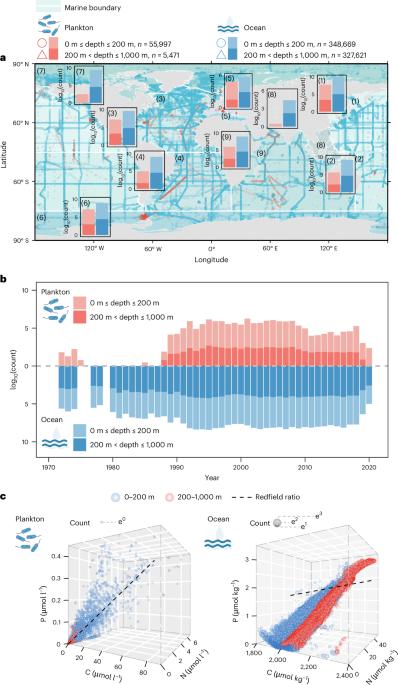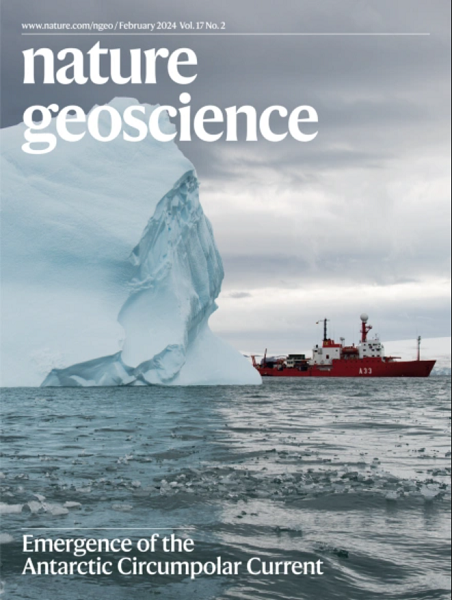Global-scale shifts in marine ecological stoichiometry over the past 50 years
IF 16.1
1区 地球科学
Q1 GEOSCIENCES, MULTIDISCIPLINARY
引用次数: 0
Abstract
The elemental stoichiometry of carbon (C), nitrogen (N) and phosphorus (P) regulates marine biogeochemical cycles and underpins the Redfield ratio paradigm. However, its global variability and response to environmental change remain poorly constrained. Here we compile a global dataset of 56,031 plankton (particulate) and 388,515 seawater (dissolved) samples from 1971 to 2020, spanning surface to 1,000 m depth, to assess spatial and temporal dynamics in marine C:N:P ratios. We show that planktonic C:P and N:P, and oceanic C:N and C:P ratios, consistently exceed Redfield ratio throughout the study period, indicating widespread deviation from canonical stoichiometry. Planktonic C:N and N:P ratios rose markedly in the late twentieth century, followed by a decline, suggesting a progressive alleviation of P limitation, probably driven by increased anthropogenic P inputs. Depth-resolved patterns show decreasing oceanic C:N and C:P, and increasing N:P ratios with depth, attributable to differential remineralization and microbial nutrient cycling. Our findings highlight dynamic, non-static stoichiometric patterns over decadal scales, offering critical observational constraints for refining the representation of elemental cycling in biogeochemical models and improving projections of marine ecosystem responses to global change. Fifty years of plankton and water samples show that the proportion of carbon, nitrogen and phosphorus in the ocean now substantially differs from the Redfield ratio, probably reflecting a reduction in phosphorus limitation.


过去50年海洋生态化学计量的全球尺度变化
碳(C)、氮(N)和磷(P)的元素化学计量调节海洋生物地球化学循环,并支持Redfield比率范式。然而,它的全球变率和对环境变化的反应仍然缺乏限制。本文利用1971年至2020年56,031个浮游生物(颗粒)和388,515个海水(溶解)样本的全球数据集,涵盖表层至1,000 m深度,以评估海洋C:N:P比率的时空动态。研究表明,浮游碳磷比和氮磷比,以及海洋碳氮比和碳磷比,在整个研究期间始终超过Redfield比,表明与标准化学计量学存在广泛偏差。浮游碳氮比和氮磷比在20世纪后期显著上升,随后下降,表明磷限制逐渐缓解,可能是由人为磷输入增加驱动的。深度分辨模式显示海洋C:N和C:P随深度的增加而减少,而N:P随深度的增加而增加,这是由于再矿化和微生物养分循环的差异。我们的研究结果强调了年代际尺度上的动态、非静态化学计量模式,为改进生物地球化学模型中元素循环的表示和改进海洋生态系统对全球变化的响应预测提供了关键的观测约束。
本文章由计算机程序翻译,如有差异,请以英文原文为准。
求助全文
约1分钟内获得全文
求助全文
来源期刊

Nature Geoscience
地学-地球科学综合
CiteScore
26.70
自引率
1.60%
发文量
187
审稿时长
3.3 months
期刊介绍:
Nature Geoscience is a monthly interdisciplinary journal that gathers top-tier research spanning Earth Sciences and related fields.
The journal covers all geoscience disciplines, including fieldwork, modeling, and theoretical studies.
Topics include atmospheric science, biogeochemistry, climate science, geobiology, geochemistry, geoinformatics, remote sensing, geology, geomagnetism, paleomagnetism, geomorphology, geophysics, glaciology, hydrology, limnology, mineralogy, oceanography, paleontology, paleoclimatology, paleoceanography, petrology, planetary science, seismology, space physics, tectonics, and volcanology.
Nature Geoscience upholds its commitment to publishing significant, high-quality Earth Sciences research through fair, rapid, and rigorous peer review, overseen by a team of full-time professional editors.
 求助内容:
求助内容: 应助结果提醒方式:
应助结果提醒方式:


